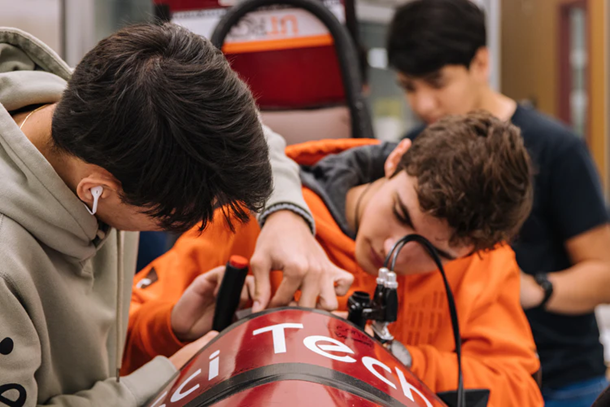By Dan Matthews
 Image Source: https://unsplash.com/photos/uXsBGF5CrpU
Image Source: https://unsplash.com/photos/uXsBGF5CrpU
As global temperatures continue to rise and inclement weather events increase in frequency, the effects of climate change are readily apparent. But there’s good news in the realm of climate change: The global call for sustainable solutions has risen alongside the issue, and young people are leading the charge.
Swedish environmentalist Greta Thunberg is, of course, the most well-known of these young activists. And while Thunberg has had to deal with her fair share of criticism and haters since first speaking out in 2018, the young woman also has plenty of support from — peers, family members, and educators alike. For Thunberg, private school education catalyzed her activism, and her teachers did their best to encourage her interest in STEM.
Education and awareness of the harsh realities of climate change, as well as technological advancements in sustainability, may serve a similar purpose for students around the world. Beginning in primary school, a STEM-focused educational model helps to lay the foundation necessary for students to take their skill sets into the future and create a better, more sustainable tomorrow. Students who are passionate about sustainability may ultimately choose a career path in which they can make a real difference.
Here’s what you need to know about facilitating an interest in STEM among students of all ages, and how technological advancements in automation, waste reduction, and more fit into the overall picture.
The Importance of Sustainability, into the Future
When developing a lesson plan wherein climate change is a major focus, start by educating yourself on the facts and the full scope of what is a vastly complex issue. Climate change affects everyone on Earth, as well as the natural world, and its implications are wide-reaching. According to the Centers for Disease Control and Prevention (CDC), “long-term changes in climate can directly or indirectly affect many aspects of society in potentially disruptive ways.”
For starters, one of the many side effects of rising temperatures is increased energy usage worldwide. Even with modest warming, researchers believe that the world will see an 11-27% uptick in demand for energy by the year 2050. And increased energy usage will result in more harmful emissions entering our atmosphere, leading to even higher temperatures and environmental damage.
To help meet increased energy needs without causing further environmental harm, more and more industries are harnessing alternative energy. Fueled by continued advancements in technology, from solar and wind power to hydroelectricity, the renewable energy sector may hit $1.1 trillion in revenue as early as 2027. Related job opportunities are expected to grow in turn, providing a stable career option for STEM students interested in sustainability.
Choosing a Sustainable Career Path
The alternative energy sector is just one of the many STEM-focused industries wherein sustainability is a high priority, however. The effects of climate change have impacted every person on the planet and every job description. Even retail and food service workers can do their part to help reduce waste within their company, and their overall carbon footprint.
But a STEM education has the potential to fuel even greater change, laying the foundation for a career in sustainable solutions. In terms of waste reduction at a company or organizational level, materials engineers are indispensable parts of the team. While generally requiring a master’s level degree, a materials engineer considers such factors as cost and environmental concerns when choosing the right materials for a particular project.
The environmental impact of the production process itself may also be scrutinized and improved upon by a sustainably-minded materials engineer. What’s more, materials engineers and similar professionals should have a wide knowledge base and strong research skills, staying on top of advancements in sustainable technology.
Where Technology and Sustainability Collide
When it comes to environmental health, it’s important to note that technological advancements aren’t always the most sustainable option and may even result in further environmental damage. Automation, for example, is potentially harmful to the natural world, if not managed properly. Along with the aforementioned emissions generated from increased energy usage, automation also adversely impacts surrounding ecosystems.
Yet leaders in robotics and automation are well aware of the environmental impact of their career path and are taking steps to help mitigate the damage. Waste reduction is a top priority for many engineers and robotic techs, and recent breakthroughs in automation are revolutionizing manufacturing across various industries. Advanced algorithms, nesting software, and computer-aided design are just a few of the advancements that are helping increase sustainability within robotics and automation.
As such, students with a passion for both computer science and sustainable solutions may be well suited for a career in automation.
Key Takeaways
You can do your part as an educator to cultivate the idea that choosing a promising career path in engineering, science, or technology isn’t always about profit; in many cases, addressing societal needs is its own reward. No matter the motivation of your students, whether income, the greater good, or a mix of the two, a STEM-based education makes for an ideal starting point.
Learn more about STEM with RobotLAB!
K12 students will graduate into a workforce that’s rife with technology in an era where robots and AI will become widely used in our everyday lives. RobotLAB is committed to bring this technology to the students and enhance their experience with tools that truly bring learning to life. Learn more!



